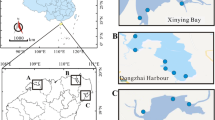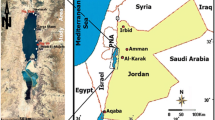Abstract
Bed sediment samples collected from the Hoogly, Godavari, Krishna and Cauvery estuaries on the east coast of India were analyzed for rare earth elements (REEs), mainly lanthanides (La–Lu), Y, a number of metals (V, Cr, Co, Ni, Zn, Ag, Cd and Pb), using Thermal Ionization Mass Spectrometry. Continental weathering plays an important role in the distribution of REEs and metals. However, metals showed wide variation in concentration among estuaries, mainly due to varying salinity, which controls complex estuarine processes, and partly to anthropogenic inputs. Factor analysis of elemental data identified two major groups of elements: (i) LREEs, HREEs, Cd, Pb and Ag, revealing an association with detritals brought in by the rivers; and (ii) V, Cr , Co, Ni and Zn, indicating complex estuarine processes and human input. LREEs are more enriched than HREEs (LREE/HREE ratio varied between 12 and 40) reflecting silicate weathering of crustal materials, and a resultant increase in LREEs in detritals. We conclude that the estuarine system constitutes 70% of LREEs and 30% of HREE flux to the Bay of Bengal.
Similar content being viewed by others
References
Biksham, G., V. Subramanian., A. L. Ramanathan & R. Van Grieken, 1991. Heavy metal distribution in the Godavari River basin. Environ. Geol. Water Sci. 17: 117–126.
Borole, D. V., S. Krishnaswami & B. L. K. Somayajulu, 1982. Uranium isotopes in rivers, estuaries and adjacent coastal sediments of western India: their weathering, transportation and oceanic budget. Geochim. Cosmochim. Acta. 46: 125–137.
Census of India 1991. Government of India 1993. 1. Paper, provisional population tables: Rural-Urban distribution, New Delhi, 58 pp.
Elderfield, H., R. Upstill-Goddard & E. R. Sholkovitz, 1990. The rare earth elements in rivers, estuaries and coastal seas and their significance to the composition of ocean waters. Geochim. Cosmochim. Acta. 54: 971–991.
Goldstein, S. J. & S. B. Jacobsen, 1988. Rare earth elements in river waters. Earth Planet. Sci. Lett. 89: 35–47.
Haskin, L. A., M. A. Haskin, F. A. Frey & T. R. Wildeman, 1968. Relative and absolute terrestrial abundances of the rare earths. In: Ahrens L.H., (ed.), Origin and Distribution of the Elements, Pergamon, Oxford: 889–911.
Henderson, P. 1984. General geochemical properties and abundances of the rare earth elements. In: Henderson P., (ed.), Rare Earth Element Geochemistry. Elsevier, Oxford: 510 pp.
Krishnan, M. S., 1982. Geology of India and Burma. CBS Publishers and Distributors., Delhi: 536 pp.
Martin, J. M. & M. Whitfield, 1983. The significance of river input of chemical elements to the ocean. In: Wong C. S., E. Boyle, K. W. Bruland, J. D. Burton and E.D. Goldberg (eds), Trace Metals in Seawater. Plenum, New York: 265–296.
Milliman, J. D. & J. P. M. Syvitski, 1992. Geomorphic/tectonic control of sediment discharge to the ocean: the importance of small mountainous rivers. J. Geol. 100: 525–544.
Naidu, A. S., 1966. Lithological and chemical facies changes in the recent deltaic sediments of the Godavari river, India. In: Shirley M. L. (ed.), Deltas in their Geological Framework. Houston Geological Society, Houston, TX: 125–157.
Ramesh, R., V. Subramanian, R. Van Grieken & L. Van't Dack, 1989. The elemental chemistry of sediments in the Krishna river basin, India. Chem. Geol. 74: 331–341.
Ramesh, R., V. Subramanian & R. Van Grieken, 1990. Heavy metal distribution in sediments of Krishna River basin, India. Env. Geol. Water Sci. 15: 207–216.
Ramanathan, A. L., V. Subramanian & P. Vaithiyanathan, 1988. Chemical and sediment characteristics of the upper reaches of the Cauvery Estuary. Ind. J. Mar. Sci. 17: 114–120.
Ramanathan, A. L., P. Vaithiyanathan, V. Subramanian & B. K. Das, 1993. Geochemistry of the Cauvery Estuary, east coast of India. Estuaries. 16: 549–474.
Ravichandran, M., 1996. Distribution of rare earth elements in sediment cores of Sabine-Neches Estuary. Mar. Poll. Bull. 32: 719–726.
Seralathan, P. & A. Seetharamaswamy, 1982. Clay minerals in the modern deltaic sediments of the Cauvery River. Ind. J. Mar. Sci. 11: 167–169.
Seralathan, P. & A. Seetharamaswamy, 1987. Geochemistry of the modern deltaic sediments of the Cauvery River, east coast of India. Ind. J. Mar. Sci. 16: 31–38.
Sholkovitz, E.R., 1995. The aquatic chemistry of rare earth elements in rivers and estuaries. Aquat. Chem. 1: 1–34.
Subramanian, V., R. Van Grieken & L. Van't Dack 1987. Heavy metals distribution in the sediments of the Ganges and Brahmaputra. Env. Geol. Wat. Sci. 9: 93–103.
Subramanian, V., L. Van't Dack & R. Van Grieken, 1985. Chemical composition of river sediments from the Indian sub-continent. Chem. Geol. 46: 271–276.
Vaithiyanathan, P., A. L. Ramanathan & V. Subramanian, 1993. Transport and distribution of heavy metals in Cauvery River. Water Air Soil Poll. 71: 13–28.
Author information
Authors and Affiliations
Rights and permissions
About this article
Cite this article
Ramesh, R., Ramanathan, A.L., James, R.A. et al. Rare earth elements and heavy metal distribution in estuarine sediments of east coast of India. Hydrobiologia 397, 89–99 (1999). https://doi.org/10.1023/A:1003646631589
Issue Date:
DOI: https://doi.org/10.1023/A:1003646631589




